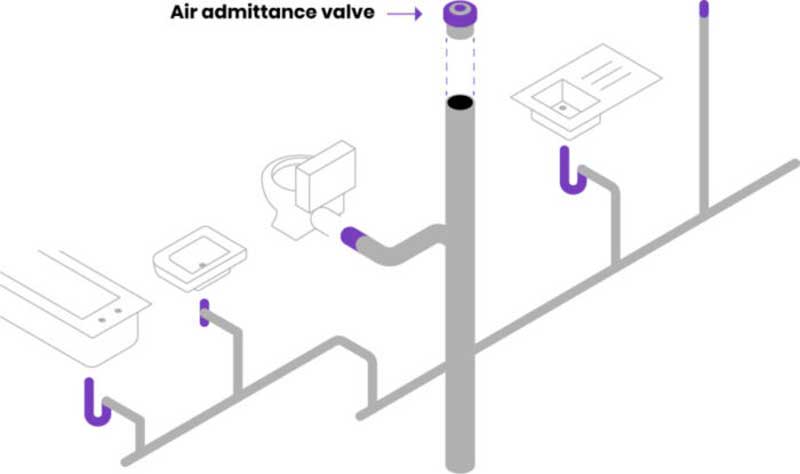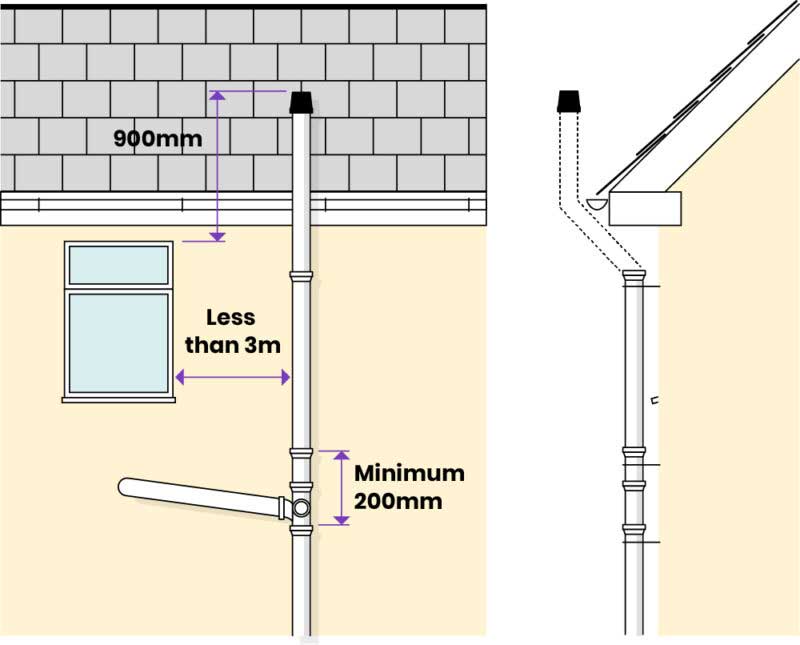What is an air admittance valve?
Air admittance valves, also known as AAVs or durgo valves, are valves that help to re-balance the pressure within a soil pipe to normal levels.
Pressure changes within soil pipes
Pressure changes occur when a toilet is flushed or any water flows within the waste pipe because air is carried along the pipe with it. This creates negative pressure. To readdress the balance, air tends to be drawn into the pipe from anywhere possible. Particularly from plugholes in baths, sinks and showers. This can cause a number of issues, including unpleasant odours being released into the home, wastewater coming up from the trap into the sink or basin, poor drainage of water and gargling sounds when drainage occurs.
This pressure change issue is traditionally solved with an open pipe outlet that is installed on the roof. This allows air to be drawn into the pipe from the external environment, preventing it from being drawn from sinks, basins and other sources within the home, thus removing the issues associated with it.
The other alternative is to use an air admittance valve in situations where an open pipe outlet isn’t possible. This can be in situations where there isn’t a pipe outlet that is more than 3 metres from a window or in situations where the building has roof windows – the pipe can let out bad odours so situating this near a window can be a bad idea!
How does an air admittance valve work?
An air admittance valve uses a clever system that is activated by negative pressure. As negative pressure occurs, the valve opens to allow air into the pipe. Once the pressure balance is recreated, the valve closes again. This allows air to be drawn in when required but prevents unwanted odours from entering the home.
Air admittance valves often feature rubber seals, to help create a complete seal, increasing the effectiveness of the valve and preventing any odours from escaping through small gaps.
Typically, air admittance valves are fitted using a push-fit joint. This allows pipes and sockets to be fitted together without the use of tools. Push-fit joints incorporate a rubber seal to create a completely watertight and airtight fitting. However, they can also be purchased with solvent weld joints. These use a chemical reaction during the application of a solvent to create a watertight and airtight permanent bond.
Where should an air admittance valve be installed?
Air admittance valves are generally placed on a soil pipe that is a minimum of 200mm above the highest water entry point – i.e. the highest point wastewater will reach within a soil pipe. They are most commonly installed at the end of a soil pipe, but can also be installed inline, using a branch.
Typically, air admittance valves are placed within lofts or cupboards to prevent them from becoming an eyesore. However, they do require a level of ventilation. As such, it’s important to ensure that they are in a space that receives a flow of air. Additionally, try to place the air admittance valve in an accessible area in case it needs access when a blockage occurs.
Can air admittance valves be used outside?
Air admittance valves can be installed externally, but this is not very common and is usually only done if the soil pipe is too close to an opening window. Open pipe outlets must be installed more than 3 metres away from a window that opens, but air admittance valves can be closer than this. If you are installing an air admittance valve externally, you’ll need to purchase a valve that is frost-resistant and unaffected by extreme weather conditions.
Potential issues with air admittance valves
Sometimes unwanted smells may be emitted, gargling sounds may occur or wastewater comes up from the soil pipes into the sink. All of which are signs that there may be an issue with the air admittance valve.
Occasionally the valve may get stuck. In this case, a simple spray of lubricant should help to loosen the valve and ensure it is back in working order.
Another reason for these issues is that the waste pipe may be blocked. This would prevent gases from being pushed down into the sewer, preventing water from draining away. To resolve this, take a look at our guide on how to unblock a drain.
Another issue may be that the air admittance valve has been installed at too low a point. To reduce the risk of this issue occurring, ensure that the valve is higher than the highest point of any shower, bath, sink or toilet.











